Special Occassion
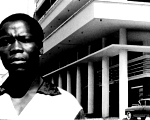 » Moi un noir / I, a Negro , Jean Rouch, FRANCE, 1958, 70′
» Moi un noir / I, a Negro , Jean Rouch, FRANCE, 1958, 70′
The film follows the struggle for survival and everyday life of Edward G. Robinson, Eddie Constantine and their friend in the neighborhood of Treichville, the poor neighbourhood of Abidjan on the Ivory Coast. These boys and their friends are young immigrants who have been forced to find their place in the margins of society. The film opens with a piercing commentary from Edward G. Robinson regarding the frustrations of being unemployed and having no money. The viewer is quickly confronted with the injustices and difficulties of their everyday existence.
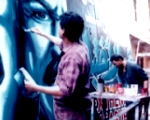 » Les diseurs d’histoires / Storytellers , Mohammed Soudani, SWITZERLAND, 2005 97′
» Les diseurs d’histoires / Storytellers , Mohammed Soudani, SWITZERLAND, 2005 97′
A film is like a journey where meetings occur. From the land of the Pharaohs to the countries where ebony is hidden - Storytellers. Why the need to tell a story? “It is absolutely necessary,” reply the story-tellers. One says, “he doesn’t know how to do anything else but films.” “The journey is long and perilous. A lot of stumbling blocks on the way!” confides a major film director. Other comments from story-tellers: “I want to develop, doing something else;” “I don’t care about the audience;” “A lot of westerners want us to make the images they want to see;” “You have to understand that the cinema is an industry;” “I’ve never understood why I struggle to make a film;” “Useless festivals which glorify exoticism and blind those who just want to be, and be themselves”, “A difficult but interesting struggle;” “Conflict between the generations is inevitable;” “We ought to live, telling stories;” Africa needs to love itself. Today, Africa has to resist and the best weapon is its culture, its identity.
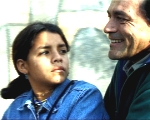 » La fĂ© de volcán / The Faith of the Volcano , Ana Poliak, ARGENTINA, 2001 90′
» La fĂ© de volcán / The Faith of the Volcano , Ana Poliak, ARGENTINA, 2001 90′
This film opens with the image of a woman on a windowsill. She knows she has to jump, but she does not know in which direction she should do this. Should she go forward or backward? She goes to the flat where she once lived. She remembers the rooms, the images, and the sounds. Her mother talks about how she once fell into a deep depression. The force of the change is compared to the awakening of a volcano. She remembers a comrade who disappeared – like many did. An unemployed 14-year-old girl Anna and Danilo (a sharpener of knives) meet in town. Both are lonely, touched by pain. They become friends. He tries to cheer Anna up by imitating his customers, she asks him about his family and friends. Danilo, however, does not like to discuss these matters. One day, and when Anna is too curious, Danilo collapses under the burden of memories of all those he was lost – those that became the nameless los desaparecidos. They part. One day Danilo does not show up – Anna visits him at his home. He tells her that the memories are too painful and that he will have to leave; go somewhere, anywhere, just leave and go away.
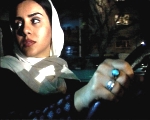 » 10 / Ten, Abbas Kiarostami, IRAN, 2002 94′
» 10 / Ten, Abbas Kiarostami, IRAN, 2002 94′
Ten: ten sequences in the emotional lives of six women and the challenges that they face at one particular moment in those lives, that could just as easily be ten sequences in the emotional life of the one same woman.
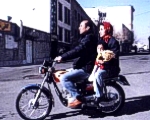 » 20 Angosht / 20 Fingers , Mania Akbari, IRAN, 2004 72′
» 20 Angosht / 20 Fingers , Mania Akbari, IRAN, 2004 72′
North, south, east, west, wherever and whenever it seems men and women have issues to deal with. This film explores gender relations and the way men and women in Iran interact. Each of the seven episodes, except one, is set on the moving vehicle. Universal issues facing couples, each episode is devoted to one discussion and the actors play a different couple in each one, with a different set of circumstances and problems. The man in this movie represents the traditional Iranian while the woman is always trying to push the limits. The man, however, is the victim. The very ideas that limit his thinking confine him within the walls that society and religion have built. The woman is the one who is on the real journey to self-discovery. She talks more freely, raises big questions and cares less about formalities and male-imopsed morality. The man is the brakes on their journey, stopping to make sure they have not progressed so far that he might get lost. Set in Iran, where women cannot expose their hair or sing, the film also deals with controversial topics such as adultery and abortion.
harvest| friends| masters| new shores| retrospective- the south of cinema
far east special | special occassion| short films and animation
 » Moi un noir / I, a Negro , Jean Rouch, FRANCE, 1958, 70′
» Moi un noir / I, a Negro , Jean Rouch, FRANCE, 1958, 70′
The film follows the struggle for survival and everyday life of Edward G. Robinson, Eddie Constantine and their friend in the neighborhood of Treichville, the poor neighbourhood of Abidjan on the Ivory Coast. These boys and their friends are young immigrants who have been forced to find their place in the margins of society. The film opens with a piercing commentary from Edward G. Robinson regarding the frustrations of being unemployed and having no money. The viewer is quickly confronted with the injustices and difficulties of their everyday existence.
 » Les diseurs d’histoires / Storytellers , Mohammed Soudani, SWITZERLAND, 2005 97′
» Les diseurs d’histoires / Storytellers , Mohammed Soudani, SWITZERLAND, 2005 97′
A film is like a journey where meetings occur. From the land of the Pharaohs to the countries where ebony is hidden - Storytellers. Why the need to tell a story? “It is absolutely necessary,” reply the story-tellers. One says, “he doesn’t know how to do anything else but films.” “The journey is long and perilous. A lot of stumbling blocks on the way!” confides a major film director. Other comments from story-tellers: “I want to develop, doing something else;” “I don’t care about the audience;” “A lot of westerners want us to make the images they want to see;” “You have to understand that the cinema is an industry;” “I’ve never understood why I struggle to make a film;” “Useless festivals which glorify exoticism and blind those who just want to be, and be themselves”, “A difficult but interesting struggle;” “Conflict between the generations is inevitable;” “We ought to live, telling stories;” Africa needs to love itself. Today, Africa has to resist and the best weapon is its culture, its identity.
 » La fĂ© de volcán / The Faith of the Volcano , Ana Poliak, ARGENTINA, 2001 90′
» La fĂ© de volcán / The Faith of the Volcano , Ana Poliak, ARGENTINA, 2001 90′
This film opens with the image of a woman on a windowsill. She knows she has to jump, but she does not know in which direction she should do this. Should she go forward or backward? She goes to the flat where she once lived. She remembers the rooms, the images, and the sounds. Her mother talks about how she once fell into a deep depression. The force of the change is compared to the awakening of a volcano. She remembers a comrade who disappeared – like many did. An unemployed 14-year-old girl Anna and Danilo (a sharpener of knives) meet in town. Both are lonely, touched by pain. They become friends. He tries to cheer Anna up by imitating his customers, she asks him about his family and friends. Danilo, however, does not like to discuss these matters. One day, and when Anna is too curious, Danilo collapses under the burden of memories of all those he was lost – those that became the nameless los desaparecidos. They part. One day Danilo does not show up – Anna visits him at his home. He tells her that the memories are too painful and that he will have to leave; go somewhere, anywhere, just leave and go away.
 » 10 / Ten, Abbas Kiarostami, IRAN, 2002 94′
» 10 / Ten, Abbas Kiarostami, IRAN, 2002 94′
Ten: ten sequences in the emotional lives of six women and the challenges that they face at one particular moment in those lives, that could just as easily be ten sequences in the emotional life of the one same woman.
 » 20 Angosht / 20 Fingers , Mania Akbari, IRAN, 2004 72′
» 20 Angosht / 20 Fingers , Mania Akbari, IRAN, 2004 72′North, south, east, west, wherever and whenever it seems men and women have issues to deal with. This film explores gender relations and the way men and women in Iran interact. Each of the seven episodes, except one, is set on the moving vehicle. Universal issues facing couples, each episode is devoted to one discussion and the actors play a different couple in each one, with a different set of circumstances and problems. The man in this movie represents the traditional Iranian while the woman is always trying to push the limits. The man, however, is the victim. The very ideas that limit his thinking confine him within the walls that society and religion have built. The woman is the one who is on the real journey to self-discovery. She talks more freely, raises big questions and cares less about formalities and male-imopsed morality. The man is the brakes on their journey, stopping to make sure they have not progressed so far that he might get lost. Set in Iran, where women cannot expose their hair or sing, the film also deals with controversial topics such as adultery and abortion.

